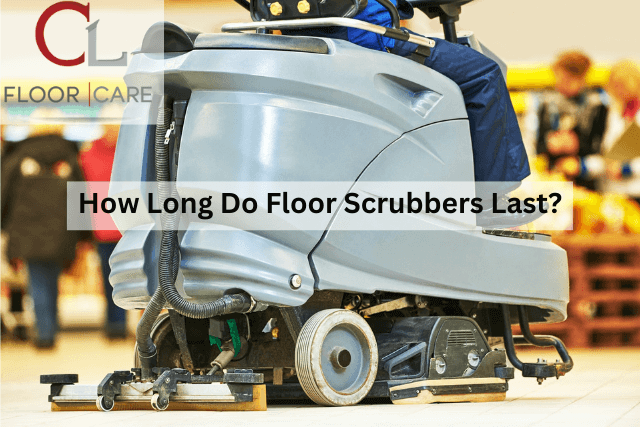How Long Do Floor Scrubbers Last?
Equipment breaking down during busy cleaning times costs money and creates hygiene problems that make your business look bad. Your floor scrubber won’t run forever, and waiting until it completely breaks forces you to buy a replacement quickly at higher prices.

Smart facility managers start planning for a new machine while their current one still works well. Knowing what to expect helps you make better money decisions and avoid problems that shut down your cleaning operations.
Most commercial floor scrubbers work reliably for 5 to 10 years. How long yours lasts depends on how much you use it, how well you look after it, and where it works. Some machines fail within three years, others keep working well for fifteen years or more.
This guide explains what affects equipment longevity, shows you warning signs that mean replacement time is coming, and helps you decide between repairs and buying new.
What Affects How Long Your Scrubber Lasts
Several things determine how many years you’ll get from your floor scrubber. Understanding these helps you know what to expect and get better performance from your machine.
Build Quality
Machines built with strong materials and good engineering last much longer than cheap ones under heavy use. A hospital running its scrubber eight hours every day needs different durability than a small office using theirs twice a week. The hospital’s cheap machine might need replacing after two years, while a better model could easily work for eight years.
Well-known companies like Tennant, Nilfisk, and Kärcher spend lots of money on research and development. They build machines for long commercial use because their customers need equipment that works reliably year after year.
Budget equipment usually costs £3,000-£5,000 up front but may need replacing within three years. Premium models that cost £8,000-£12,000 often work well for eight to ten years. The higher price usually pays for itself through fewer repair bills and a longer working life.
Where They Are Used
Food processing plants expose equipment to oils and acids that slowly damage seals and internal parts. Retail stores face mainly foot traffic and occasional spills. Construction sites have concrete dust and debris that wear down moving parts like sandpaper. Office buildings are much easier on equipment.
Temperature changes between storage and work areas make seals expand and shrink, leading to early failure. High humidity causes rust, while very dry conditions make rubber parts crack.
How Long Are They Used
Daily working hours predict equipment life better than calendar age. A scrubber running eight hours daily faces different stress than one used occasionally on weekends. Careful operators who know the right techniques help machines reach their full potential. Rough handling dramatically shortens equipment life.
We’ve seen identical machines in similar places where one lasts ten years and another needs major repairs after three, just because of how people treated them.
Regular Care Makes the Biggest Difference
Consistent cleaning, replacing parts on time, and following the manufacturer’s service schedule stop small problems from becoming big ones that cost thousands to fix. Professional servicing every six to twelve months catches problems early. Many businesses find that spending £200-£400 each year on professional care prevents thousands in emergency repair costs.
Realistic Service Life Expectations
Most commercial floor scrubbers give 5 to 10 years of good performance under normal conditions. Well-maintained premium machines often last longer, cleaning effectively for ten years or more. Budget equipment usually needs replacing after 3 to 5 years, even under ideal conditions.
Battery Performance Varies by Type
Traditional lead acid batteries are most common, usually lasting 2 to 5 years, depending on how often you use them and your charging habits. A replacement battery can cost anywhere in the region from £150 to £1,000.
Gel batteries and AGM types (which use fibreglass mats to soak up battery acid) give 18 to 24 months of service under normal conditions. Poor charging habits or extreme temperatures can make these batteries fail within months.
Newer TPPL batteries (which use thinner lead plates for better performance) last much longer. No matter what battery type you have, good charging habits can double battery life. Don’t run batteries completely flat before recharging, and keep them at recommended storage temperatures.
When to Replace Components
Brushes and cleaning pads wear out the most because they touch surfaces directly. You’ll need to replace them every 6 months to one year, depending on how much you use the machine and what types of floors you clean.
Squeegees wear out relatively quickly, and most places replace them every 3 to 6 months. Well-maintained motors often last the machine’s whole life, though vacuum motors sometimes fail early if operators let moisture and foam get inside.
Solution and recovery tanks handle wear well, with most manufacturers covering them for 8 to 10 years. Hoses get more abuse during daily use and commonly need replacing every few years.
Warning Signs That You Need a Replacement
Watch for early signs rather than waiting for complete equipment failure.
Performance Problems
Scrubbers that don’t clean well even when using fresh brushes, pads, and cleaning solutions have serious mechanical problems. Machines that leave dirt behind or need multiple passes may have reached the end of their useful life.
Battery performance getting worse, even with new batteries, often means underlying electrical or mechanical problems. When machines that once cleaned for four hours struggle to complete two hours of work, major parts might be about to fail.
Repair Costs Get Too High
When monthly repair bills consistently go over £300-£500, and this is more than 40% of what annual lease payments would be for new equipment, replacement usually makes financial sense.
Problems often spread, with repairs to one system leading to failures in related parts. Older machines may need constant attention that disrupts cleaning schedules and increases labour costs beyond actual repair bills.
Parts Become Difficult to Source
Discontinued models or old parts make maintenance impractical and expensive. When replacement parts become difficult to get or cost more than 60% of their original price, buying new equipment makes more sense.
Manufacturers usually keep parts available for 7 to 10 years after stopping production of a model. Beyond this time, finding genuine parts becomes increasingly difficult and expensive.
Planning for Warranty and Replacement
Before worrying about replacement costs, check if your equipment is still under warranty. Manufacturer warranties cover production defects and material failures but don’t cover damage from misuse, abuse, or normal part wear.
Warranty periods vary by manufacturer and model, with some offering 3-year parts and labour coverage. Travel warranties cover technician travel costs to your building for warranty repairs. Without this coverage, you might pay £100-£200 per service call just for the technician to show up.
Keep warranty coverage by following manufacturer recommendations for operation and maintenance. Using non-approved parts or cleaning chemicals can cancel warranty coverage.
Smart Budget Planning
Many operations successfully use the 40% rule. When yearly repair costs go over 40% of the new equipment cost, replacement usually makes financial sense. For example, if similar new equipment costs £10,000 and you’re spending £4,000 each year on repairs, it’s time to replace.
Set aside money each year for equipment replacement to spread costs over time and make funds available when needed. Calculate total ownership cost when budgeting, including purchase price, maintenance expenses, and operating costs.
Getting Maximum Value from Your Machine
Getting the best return requires combining smart equipment choice with consistent operating practices.
Proper Storage and Training
Store equipment in clean, dry, well-ventilated areas away from extreme temperatures and harsh chemicals. Don’t store machines in unheated warehouses during winter or areas with direct sunlight during summer. Temperature extremes make seals crack and electrical parts fail early.
Good operator training pays off throughout equipment life. Well-trained staff understand proper operating techniques and spot early problem signs. Investing £500-£1,000 in thorough training often saves thousands in repair costs.
Untrained operators often make mistakes like overfilling solution tanks, using the wrong cleaning chemicals, or ignoring unusual noises that signal developing problems.
Use Approved Parts and Chemicals
Use manufacturer-approved replacement parts and cleaning chemicals to keep equipment working properly and preserve warranty coverage. Cheaper alternatives may cost 20-30% less at first, but often wear out faster and may damage other parts.
Wrong cleaning chemicals can cancel warranties and damage tanks, seals, and pump systems. The money saved from cheaper chemicals rarely makes up for potential repair costs.
Schedule Regular Maintenance
Create maintenance schedules based on operating hours rather than calendar dates. Modern machines often have hour metres that make scheduling simple. Basic logbooks work well for older equipment.
Professional servicing gives you technical expertise and thorough inspections that spot developing problems early. Fixing issues during scheduled maintenance costs much less than emergency repairs during peak operating times.
Making the Right Equipment Decision
Quality equipment that gets proper maintenance should give 5 to 10 years of reliable service under normal operating conditions. Success depends equally on equipment choice and operating practices.
Premium machines operated without due care will disappoint and fail early. Modest investments can work better than expected when combined with proper care and training.
When the time comes for a replacement, think carefully about your current and future needs. Consider things like whether you are planning to upsize or downsize your facility, cleaning frequency requirements, and new technology benefits. The right equipment, properly maintained and operated, will serve your facility well for years to come.



